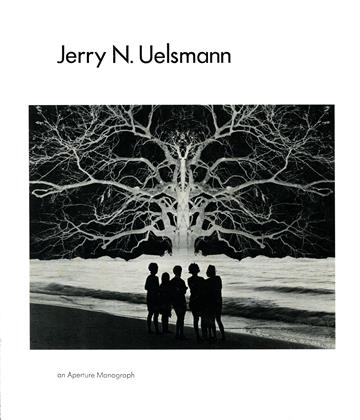CHRONOLOGY
1934 Born in Detroit, Jerry Norman Uelsmann, second son of Mr. and Mrs. Norman Uelsmann. The father is an independent grocer. Attends public schools; indifferent student.
1950 While in high school develops, in part from father's and brother's hobby, a typical vocational interest in photography.
1953 Enters Rochester Institute of Technology in its first fouryear degree program in photography. Deeply influenced and encouraged by Ralph Hattersley and also by Minor White, both on the faculty. Limited contact with the George Eastman House.
1957 Receives B.F.A. degree. Marries Marilynn Kamischke of Detroit. First published photograph in Photography Annual 1957.
195758 Enters Indiana University Graduate School, Bloomington, in audio-visual communications; continuation of a vocational interest in the medium. Serves as graduate assistant in laboratory. Graduates with M.S. degree but disillusioned with the field.
195860 Transfers to the Department of Art, Indiana University Graduate School. Henry Holmes Smith, a faculty member, highly influential as a provocateur and In coalescing the realization of photography’s potential as a creative medium. Considers Hattersley, White, and Smith to be primary photographic influences. Laboratory assistantship continues. Intensive study in art history, also studies in design. With Jack Welpott, a fellow graduate student, completes five programs on photography for local educational television station. Graduates with M.F.A. degree.
1960 Interim Instructor, Deportment of Art, University of Florida, Gainesville. Van Deren Coke also on the faculty.
1962 I nstructor, University of Florida. Founding member of The Society for Photographic Education; delivers paper, “The Interrelationship of Image and Technique," to that body in Rochester. First group exhibition with substantial representation, “Three Photographers," George Eastman House. Selected for "New Talent USA," Art in America. Multiple printing now an integral part of visual vocabulary, although isolated examples appear earlier.
1963 F irst major one-man exhibition (103 photographs) at the Jacksonville Art Museum, Jacksonville, Florida.
1964 Assistant Professor of Art, University of Florida. Exhibits with the Association of Heliographers in New York. First important portfolio and essay on his work, with picture selection and layout by himself, in Contemporary Photographer.
1965 Second paper, “Post-visualization," delivered to The Society for Photographic Education in Chicago. Sees first floating tree. Completes building an architect-designed home in Gainesville,upon occupancy acquires first darkroom of his own (prior to this date relied on various university facilities for all personal photography). This date marks the beginning of his individual realization of the "darkroom as a visual research lab." Begins with two enlargers (four at present) and gradually acquires additional equipment.
1966 Associate Professor of Art, University of Florida. Elected to the Board of Directors, The Society for Photographic Education.
1967 One-man exhibition at The Museum of Modern Art, direefed by John Szarkowski. On third application, awarded a Guggenheim Fellowship for “Experiments in Multiple Printing Techniques in Photography." Remains in Gainesville during fellowship period. Featured on national educational television program, "Time, Light, and Vision: The Art of Photography," written by Peter C. Bunnell. First significant European publication of his work and ideas in Camera.
1968 Extensive national lecture and printmaking demonstration schedule including Rhode Island School of Design, Massachusetts Institute of Technology, University of Iowa, Ohio University, Art Institute of Chicago, San Francisco Museum of Art, Purdue University, Addison Gallery of American Art, George Eastman House, The Friends of Photography, University of St. Thomas, and Wheaton College. Continues to present. Commissioned to create one of the "Great Ideas of Western Man" advertisements by the Container Corporation of America. First in-depth analysis of the body of his work by William E. Parker in Aperture.
1969 Professor of Art, University of Florida. Workshop at The Center of the Eye, Aspen (given again in 1970).
1970 Invited to deliver the Fourth Bertram Cox Memorial Lecture by the Royal Photographic Society of Great Britain, London (to be given early in 1971). "Post-visualization Workshop," University of California Extension, Berkeley. Leave from the University of Florida for the academic year under a Faculty Development Grant. In October, cited for Special Recognition by the American Society of Magazine Photographers for “his outstanding contribution to photography."
 View Full Issue
View Full Issue
More From This Issue
Subscribers can unlock every article Aperture has ever published Subscribe Now
Peter C. Bunnell
-

Leslie Krims
Fall 1967 By Peter C. Bunnell -

A Portrait For Us Today—And Tomorrow
Spring 1968 By Peter C. Bunnell -

Bibliography
Winter 1969 By Peter C. Bunnell -

Bibliography
Winter 1970 By Peter C. Bunnell -

Bibliography
Winter 1978 By Peter C. Bunnell -

Comment And Review
Summer 1967 By Peter C. Bunnell, Frederick D. Leach, Jonathan Green, 1 more ...






